蓝色月季转基因育种
- 格式:doc
- 大小:228.50 KB
- 文档页数:15
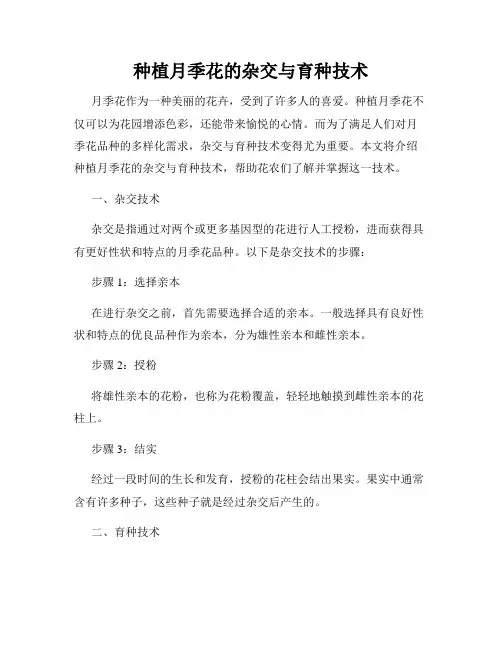
种植月季花的杂交与育种技术月季花作为一种美丽的花卉,受到了许多人的喜爱。
种植月季花不仅可以为花园增添色彩,还能带来愉悦的心情。
而为了满足人们对月季花品种的多样化需求,杂交与育种技术变得尤为重要。
本文将介绍种植月季花的杂交与育种技术,帮助花农们了解并掌握这一技术。
一、杂交技术杂交是指通过对两个或更多基因型的花进行人工授粉,进而获得具有更好性状和特点的月季花品种。
以下是杂交技术的步骤:步骤1:选择亲本在进行杂交之前,首先需要选择合适的亲本。
一般选择具有良好性状和特点的优良品种作为亲本,分为雄性亲本和雌性亲本。
步骤2:授粉将雄性亲本的花粉,也称为花粉覆盖,轻轻地触摸到雌性亲本的花柱上。
步骤3:结实经过一段时间的生长和发育,授粉的花柱会结出果实。
果实中通常含有许多种子,这些种子就是经过杂交后产生的。
二、育种技术育种技术是指在杂交的基础上,通过有选择地培育和选取种子中的优良个体,进一步培养出更具商业价值的月季花品种。
以下是育种技术的步骤:步骤1:种子处理将经过杂交获得的种子进行处理,以提高发芽率和种子的存活率。
常见的种子处理方法包括浸泡、消毒和防治病虫害等。
步骤2:播种和培养将处理后的种子均匀撒播在育苗盘或育苗盆中,然后放置在适宜的温度和湿度条件下进行培育。
同时需要合理给予光照和水分,以促进幼苗的生长和发育。
步骤3:选优在幼苗生长的过程中,通过观察和比较,选出具有较好性状和特点的个体。
可以根据花色、花型、花香、抗病性等进行评估和筛选。
步骤4:繁殖选中优良个体后,采用嫁接或扦插等方法进行繁殖和繁育。
繁殖后的新苗再经过一定的培育和观察期,最终成为新的月季花品种。
通过杂交与育种技术,人们不仅可以获得新颖、独特的月季花品种,还能提高月季花的抗病虫害能力,增加其商品价值和市场竞争力。
总结种植月季花的杂交与育种技术是培育新品种和改良月季花性状的重要手段。
花农们通过选择合适的亲本、进行人工授粉,再经过育种选优和繁殖等步骤,最终可以培育出更具商业价值的月季花品种。
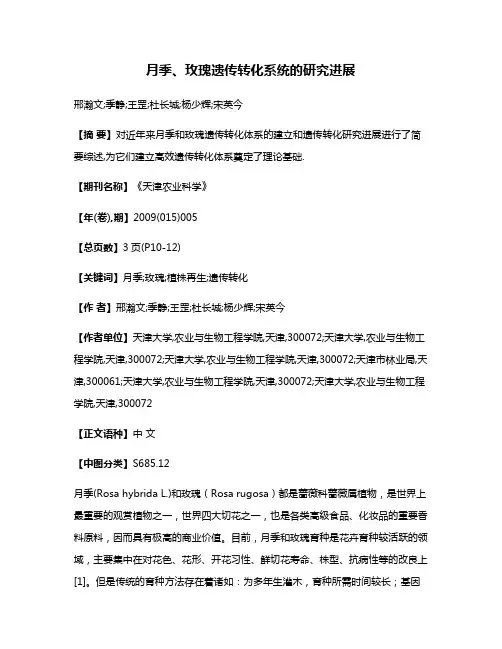
月季、玫瑰遗传转化系统的研究进展邢瀚文;季静;王罡;杜长城;杨少辉;宋英今【摘要】对近年来月季和玫瑰遗传转化体系的建立和遗传转化研究进展进行了简要综述,为它们建立高效遗传转化体系奠定了理论基础.【期刊名称】《天津农业科学》【年(卷),期】2009(015)005【总页数】3页(P10-12)【关键词】月季;玫瑰;植株再生;遗传转化【作者】邢瀚文;季静;王罡;杜长城;杨少辉;宋英今【作者单位】天津大学,农业与生物工程学院,天津,300072;天津大学,农业与生物工程学院,天津,300072;天津大学,农业与生物工程学院,天津,300072;天津市林业局,天津,300061;天津大学,农业与生物工程学院,天津,300072;天津大学,农业与生物工程学院,天津,300072【正文语种】中文【中图分类】S685.12月季(Rosa hybrida L.)和玫瑰(Rosa rugosa)都是蔷薇科蔷薇属植物,是世界上最重要的观赏植物之一,世界四大切花之一,也是各类高级食品、化妆品的重要香料原料,因而具有极高的商业价值。
目前,月季和玫瑰育种是花卉育种较活跃的领域,主要集中在对花色、花形、开花习性、鲜切花寿命、株型、抗病性等的改良上[1]。
但是传统的育种方法存在着诸如:为多年生灌木,育种所需时间较长;基因资源有限,染色体数目及倍性差异使远缘杂交难以成功;生长一致性、开花同时性等多基因控制性状难以改良等问题。
20世纪90年代发展起来的以组织培养为基础的转基因技术为月季和玫瑰育种提供了一条新途径。
这种方法不但使品种在外源基因所控制的性状上发生改变,其性状保持相对稳定,还可利用来自其他生物类型的基因,创造更优良的品种[2]。
笔者着重介绍了月季遗传转化体系的建立及遗传转化方面的研究进展,为进行月季基因工程改良,培育月季优秀新品种提供借鉴。
同时,玫瑰与月季在遗传转化方面非常相似,在此不再赘述。
月季遗传转化体系的建立是转基因技术的重要前提条件,转基因成功与否在很大程度上依赖于再生体系是否高效。
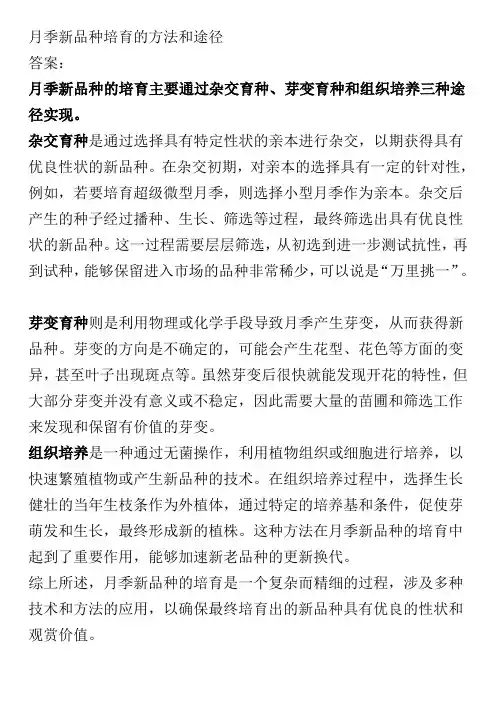
月季新品种培育的方法和途径
答案:
月季新品种的培育主要通过杂交育种、芽变育种和组织培养三种途径实现。
杂交育种是通过选择具有特定性状的亲本进行杂交,以期获得具有优良性状的新品种。
在杂交初期,对亲本的选择具有一定的针对性,例如,若要培育超级微型月季,则选择小型月季作为亲本。
杂交后产生的种子经过播种、生长、筛选等过程,最终筛选出具有优良性状的新品种。
这一过程需要层层筛选,从初选到进一步测试抗性,再到试种,能够保留进入市场的品种非常稀少,可以说是“万里挑一”。
芽变育种则是利用物理或化学手段导致月季产生芽变,从而获得新品种。
芽变的方向是不确定的,可能会产生花型、花色等方面的变异,甚至叶子出现斑点等。
虽然芽变后很快就能发现开花的特性,但大部分芽变并没有意义或不稳定,因此需要大量的苗圃和筛选工作来发现和保留有价值的芽变。
组织培养是一种通过无菌操作,利用植物组织或细胞进行培养,以快速繁殖植物或产生新品种的技术。
在组织培养过程中,选择生长健壮的当年生枝条作为外植体,通过特定的培养基和条件,促使芽萌发和生长,最终形成新的植株。
这种方法在月季新品种的培育中起到了重要作用,能够加速新老品种的更新换代。
综上所述,月季新品种的培育是一个复杂而精细的过程,涉及多种技术和方法的应用,以确保最终培育出的新品种具有优良的性状和观赏价值。
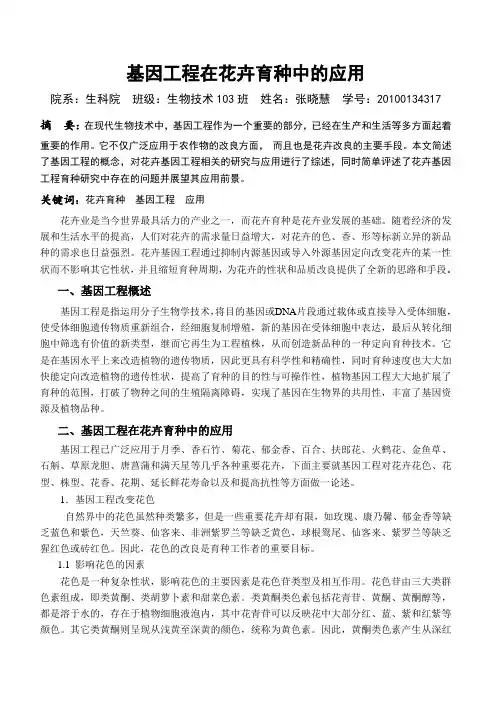
基因工程在花卉育种中的应用院系:生科院班级:生物技术103班姓名:张晓慧学号:20100134317 摘要:在现代生物技术中,基因工程作为一个重要的部分,已经在生产和生活等多方面起着重要的作用。
它不仅广泛应用于农作物的改良方面,而且也是花卉改良的主要手段。
本文简述了基因工程的概念,对花卉基因工程相关的研究与应用进行了综述,同时简单评述了花卉基因工程育种研究中存在的问题并展望其应用前景。
关键词:花卉育种基因工程应用花卉业是当今世界最具活力的产业之一,而花卉育种是花卉业发展的基础。
随着经济的发展和生活水平的提高,人们对花卉的需求量日益增大,对花卉的色、香、形等标新立异的新品种的需求也日益强烈。
花卉基因工程通过抑制内源基因或导入外源基因定向改变花卉的某一性状而不影响其它性状,并且缩短育种周期,为花卉的性状和品质改良提供了全新的思路和手段。
一、基因工程概述基因工程是指运用分子生物学技术,将目的基因或DNA片段通过载体或直接导入受体细胞,使受体细胞遗传物质重新组合,经细胞复制增殖,新的基因在受体细胞中表达,最后从转化细胞中筛选有价值的新类型,继而它再生为工程植株,从而创造新品种的一种定向育种技术。
它是在基因水平上来改造植物的遗传物质,因此更具有科学性和精确性,同时育种速度也大大加快能定向改造植物的遗传性状,提高了育种的目的性与可操作性,植物基因工程大大地扩展了育种的范围,打破了物种之间的生殖隔离障碍,实现了基因在生物界的共用性,丰富了基因资源及植物品种。
二、基因工程在花卉育种中的应用基因工程已广泛应用于月季、香石竹、菊花、郁金香、百合、扶郎花、火鹤花、金鱼草、石斛、草原龙胆、唐菖蒲和满天星等几乎各种重要花卉,下面主要就基因工程对花卉花色、花型、株型、花香、花期、延长鲜花寿命以及和提高抗性等方面做一论述。
1.基因工程改变花色自然界中的花色虽然种类繁多,但是一些重要花卉却有限,如玫瑰、康乃馨、郁金香等缺乏蓝色和紫色,天竺葵、仙客来、非洲紫罗兰等缺乏黄色,球根鸳尾、仙客来、紫罗兰等缺乏猩红色或砖红色。
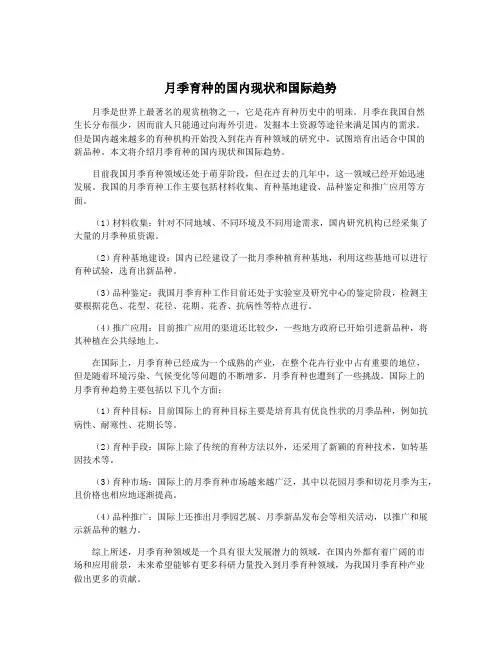
月季育种的国内现状和国际趋势月季是世界上最著名的观赏植物之一,它是花卉育种历史中的明珠。
月季在我国自然生长分布很少,因而前人只能通过向海外引进,发掘本土资源等途径来满足国内的需求。
但是国内越来越多的育种机构开始投入到花卉育种领域的研究中,试图培育出适合中国的新品种。
本文将介绍月季育种的国内现状和国际趋势。
目前我国月季育种领域还处于萌芽阶段,但在过去的几年中,这一领域已经开始迅速发展。
我国的月季育种工作主要包括材料收集、育种基地建设、品种鉴定和推广应用等方面。
(1)材料收集:针对不同地域、不同环境及不同用途需求,国内研究机构已经采集了大量的月季种质资源。
(2)育种基地建设:国内已经建设了一批月季种植育种基地,利用这些基地可以进行育种试验,选育出新品种。
(3)品种鉴定:我国月季育种工作目前还处于实验室及研究中心的鉴定阶段,检测主要根据花色、花型、花径、花期、花香、抗病性等特点进行。
(4)推广应用:目前推广应用的渠道还比较少,一些地方政府已开始引进新品种,将其种植在公共绿地上。
在国际上,月季育种已经成为一个成熟的产业,在整个花卉行业中占有重要的地位,但是随着环境污染、气候变化等问题的不断增多,月季育种也遭到了一些挑战。
国际上的月季育种趋势主要包括以下几个方面:(1)育种目标:目前国际上的育种目标主要是培育具有优良性状的月季品种,例如抗病性、耐寒性、花期长等。
(2)育种手段:国际上除了传统的育种方法以外,还采用了新颖的育种技术,如转基因技术等。
(3)育种市场:国际上的月季育种市场越来越广泛,其中以花园月季和切花月季为主,且价格也相应地逐渐提高。
(4)品种推广:国际上还推出月季园艺展、月季新品发布会等相关活动,以推广和展示新品种的魅力。
综上所述,月季育种领域是一个具有很大发展潜力的领域,在国内外都有着广阔的市场和应用前景,未来希望能够有更多科研力量投入到月季育种领域,为我国月季育种产业做出更多的贡献。
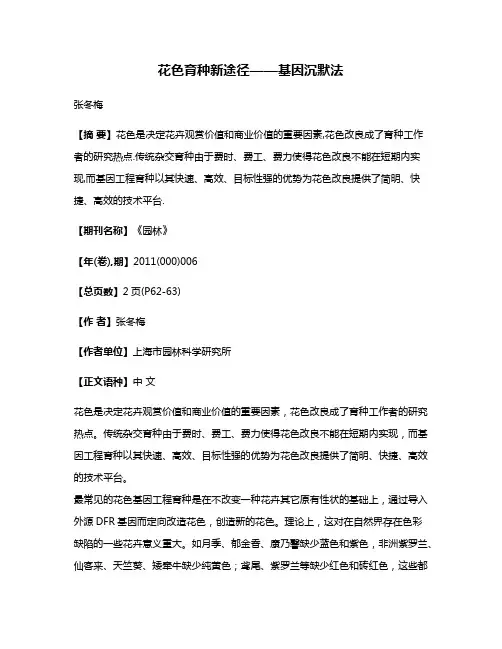
花色育种新途径——基因沉默法张冬梅【摘要】花色是决定花卉观赏价值和商业价值的重要因素,花色改良成了育种工作者的研究热点.传统杂交育种由于费时、费工、费力使得花色改良不能在短期内实现,而基因工程育种以其快速、高效、目标性强的优势为花色改良提供了简明、快捷、高效的技术平台.【期刊名称】《园林》【年(卷),期】2011(000)006【总页数】2页(P62-63)【作者】张冬梅【作者单位】上海市园林科学研究所【正文语种】中文花色是决定花卉观赏价值和商业价值的重要因素,花色改良成了育种工作者的研究热点。
传统杂交育种由于费时、费工、费力使得花色改良不能在短期内实现,而基因工程育种以其快速、高效、目标性强的优势为花色改良提供了简明、快捷、高效的技术平台。
最常见的花色基因工程育种是在不改变一种花卉其它原有性状的基础上,通过导入外源DFR基因而定向改造花色,创造新的花色。
理论上,这对在自然界存在色彩缺陷的一些花卉意义重大。
如月季、郁金香、康乃馨缺少蓝色和紫色,非洲紫罗兰、仙客来、天竺葵、矮牵牛缺少纯黄色;鸢尾、紫罗兰等缺少红色和砖红色,这些都是运用传统杂交育种方法无法解决的问题。
基于这些出发点,1987年德国人Meyer等人利用转基因的方法首次将从玉米中克隆出的A1基因导入矮牵牛中,获得了砖红色的矮牵牛新品种;荷兰S&G种子公司用玉米的DFR基因转化矮牵牛,培育出橙色的矮牵牛新品种。
但是这种针对某种花卉本身缺乏该基因,可直接导入外源结构基因改变其花色,以创造新奇品种的转基因法只对单基因控制的花色有效,如一些控制红花、白花、黄花的基因。
对于蓝色花,利用上述的导入外源基因的方法则很难随心所欲地进行蓝色的控制。
不是简单地通过从鸢尾中克隆出蓝色基因,把它转入到月季中就能获得蓝色月季。
究其原因,合成蓝色翠雀素所必需的F3′5′H酶基因不是单基因控制的花色,只有翠雀素、黄酮醇和较高液泡pH值三者协同作用才能创造出蓝色花色,蓝色花的形成显然受多种因素的影响。
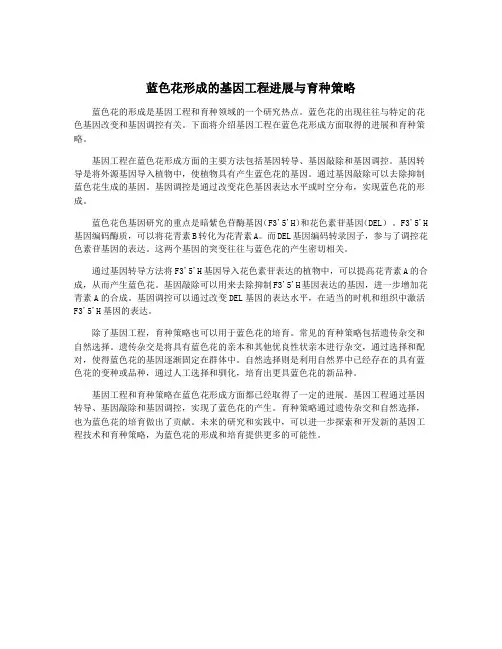
蓝色花形成的基因工程进展与育种策略蓝色花的形成是基因工程和育种领域的一个研究热点。
蓝色花的出现往往与特定的花色基因改变和基因调控有关。
下面将介绍基因工程在蓝色花形成方面取得的进展和育种策略。
基因工程在蓝色花形成方面的主要方法包括基因转导、基因敲除和基因调控。
基因转导是将外源基因导入植物中,使植物具有产生蓝色花的基因。
通过基因敲除可以去除抑制蓝色花生成的基因。
基因调控是通过改变花色基因表达水平或时空分布,实现蓝色花的形成。
蓝色花色基因研究的重点是暗紫色苷酶基因(F3'5'H)和花色素苷基因(DEL)。
F3'5'H 基因编码酶质,可以将花青素B转化为花青素A。
而DEL基因编码转录因子,参与了调控花色素苷基因的表达。
这两个基因的突变往往与蓝色花的产生密切相关。
通过基因转导方法将F3'5'H基因导入花色素苷表达的植物中,可以提高花青素A的合成,从而产生蓝色花。
基因敲除可以用来去除抑制F3'5'H基因表达的基因,进一步增加花青素A的合成。
基因调控可以通过改变DEL基因的表达水平,在适当的时机和组织中激活F3'5'H基因的表达。
除了基因工程,育种策略也可以用于蓝色花的培育。
常见的育种策略包括遗传杂交和自然选择。
遗传杂交是将具有蓝色花的亲本和其他优良性状亲本进行杂交,通过选择和配对,使得蓝色花的基因逐渐固定在群体中。
自然选择则是利用自然界中已经存在的具有蓝色花的变种或品种,通过人工选择和驯化,培育出更具蓝色花的新品种。
基因工程和育种策略在蓝色花形成方面都已经取得了一定的进展。
基因工程通过基因转导、基因敲除和基因调控,实现了蓝色花的产生。
育种策略通过遗传杂交和自然选择,也为蓝色花的培育做出了贡献。
未来的研究和实践中,可以进一步探索和开发新的基因工程技术和育种策略,为蓝色花的形成和培育提供更多的可能性。
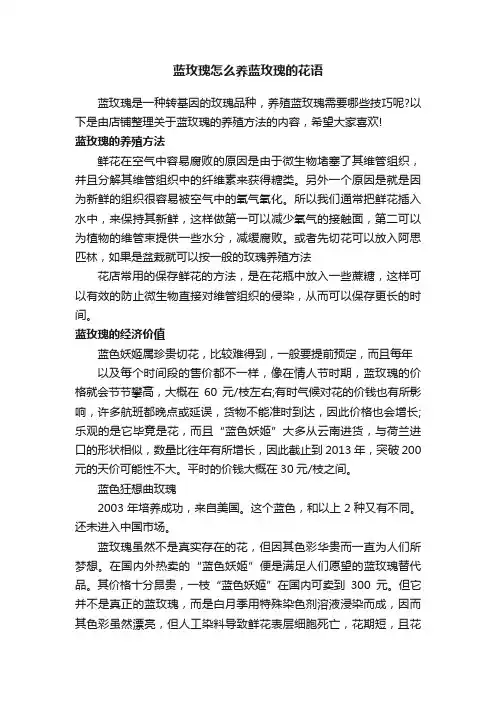
蓝玫瑰怎么养蓝玫瑰的花语蓝玫瑰是一种转基因的玫瑰品种,养殖蓝玫瑰需要哪些技巧呢?以下是由店铺整理关于蓝玫瑰的养殖方法的内容,希望大家喜欢!蓝玫瑰的养殖方法鲜花在空气中容易腐败的原因是由于微生物堵塞了其维管组织,并且分解其维管组织中的纤维素来获得糖类。
另外一个原因是就是因为新鲜的组织很容易被空气中的氧气氧化。
所以我们通常把鲜花插入水中,来保持其新鲜,这样做第一可以减少氧气的接触面,第二可以为植物的维管束提供一些水分,减缓腐败。
或者先切花可以放入阿思匹林,如果是盆栽就可以按一般的玫瑰养殖方法花店常用的保存鲜花的方法,是在花瓶中放入一些蔗糖,这样可以有效的防止微生物直接对维管组织的侵染,从而可以保存更长的时间。
蓝玫瑰的经济价值蓝色妖姬属珍贵切花,比较难得到,一般要提前预定,而且每年以及每个时间段的售价都不一样,像在情人节时期,蓝玫瑰的价格就会节节攀高,大概在60元/枝左右;有时气候对花的价钱也有所影响,许多航班都晚点或延误,货物不能准时到达,因此价格也会增长;乐观的是它毕竟是花,而且“蓝色妖姬”大多从云南进货,与荷兰进口的形状相似,数量比往年有所增长,因此截止到2013年,突破200元的天价可能性不大。
平时的价钱大概在30元/枝之间。
蓝色狂想曲玫瑰2003年培养成功,来自美国。
这个蓝色,和以上2种又有不同。
还未进入中国市场。
蓝玫瑰虽然不是真实存在的花,但因其色彩华贵而一直为人们所梦想。
在国内外热卖的“蓝色妖姬”便是满足人们愿望的蓝玫瑰替代品。
其价格十分昂贵,一枝“蓝色妖姬”在国内可卖到300元。
但它并不是真正的蓝玫瑰,而是白月季用特殊染色剂溶液浸染而成,因而其色彩虽然漂亮,但人工染料导致鲜花表层细胞死亡,花期短,且花开不大。
蓝玫瑰的花语蓝玫瑰的花语:稀世珍爱1、奇迹与不可能实现的事。
2、永远不可能得到的东西,珍贵,稀有。
3、神秘或者不为人知的爱情、不为人知的秘密。
暗恋你,却又开不了口,每天想的都是你,你是否也会想起我。
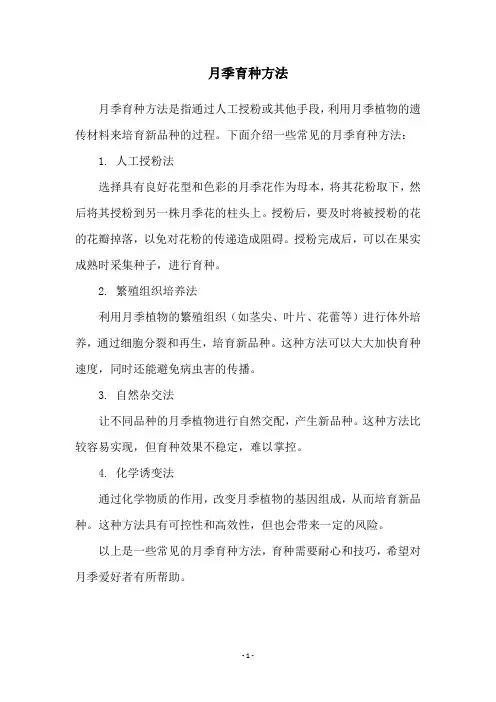
月季育种方法
月季育种方法是指通过人工授粉或其他手段,利用月季植物的遗传材料来培育新品种的过程。
下面介绍一些常见的月季育种方法: 1. 人工授粉法
选择具有良好花型和色彩的月季花作为母本,将其花粉取下,然后将其授粉到另一株月季花的柱头上。
授粉后,要及时将被授粉的花的花瓣掉落,以免对花粉的传递造成阻碍。
授粉完成后,可以在果实成熟时采集种子,进行育种。
2. 繁殖组织培养法
利用月季植物的繁殖组织(如茎尖、叶片、花蕾等)进行体外培养,通过细胞分裂和再生,培育新品种。
这种方法可以大大加快育种速度,同时还能避免病虫害的传播。
3. 自然杂交法
让不同品种的月季植物进行自然交配,产生新品种。
这种方法比较容易实现,但育种效果不稳定,难以掌控。
4. 化学诱变法
通过化学物质的作用,改变月季植物的基因组成,从而培育新品种。
这种方法具有可控性和高效性,但也会带来一定的风险。
以上是一些常见的月季育种方法,育种需要耐心和技巧,希望对月季爱好者有所帮助。
- 1 -。

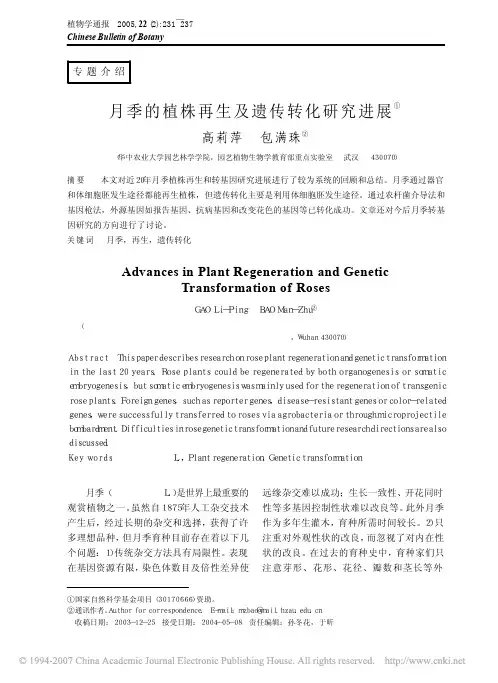
植物学通报 2005, 22 (2): 231 ̄237Chinese Bulletin of Botany①国家自然科学基金项目(30170666)资助。
②通讯作者。
Author for correspondence. E-mail: mzbao@mail.hzau.edu.cn收稿日期:2003-12-25 接受日期:2004-05-08 责任编辑:孙冬花, 于昕专题介绍月季的植株再生及遗传转化研究进展①高莉萍 包满珠②(华中农业大学园艺林学学院, 园艺植物生物学教育部重点实验室 武汉 430070)摘要 本文对近20年月季植株再生和转基因研究进展进行了较为系统的回顾和总结。
月季通过器官和体细胞胚发生途径都能再生植株,但遗传转化主要是利用体细胞胚发生途径。
通过农杆菌介导法和基因枪法,外源基因如报告基因、抗病基因和改变花色的基因等已转化成功。
文章还对今后月季转基因研究的方向进行了讨论。
关键词 月季,再生,遗传转化Advances in Plant Regeneration and GeneticTransformation of RosesGAO Li-Ping BAO Man-Zhu②(Key Laboratory of Horticulture Biology, Ministry of Education, College of Horticulture and Forestry, Huazhong Agricultural University, Wuhan 430070)Abstract This paper describes research on rose plant regeneration and genetic transformationin the last 20 years. Rose plants could be regenerated by both organogenesis or somaticembryogenesis, but somatic embryogenesis was mainly used for the regeneration of transgenicrose plants. Foreign genes, such as reporter genes, disease-resistant genes or color-relatedgenes, were successfully transferred to roses via agrobacteria or through microprojectilebombardment. Difficulties in rose genetic transformation and future research directions are alsodiscussed.Key words Rosa hybrida L., Plant regeneration, Genetic transformation月季(Rosa hybrida L.)是世界上最重要的观赏植物之一。
野生花卉资源及在城市绿化中的开发利用1.我国野生花卉资源现状及其特点野生花卉是指现在仍在原产地处于天然自生状态的观赏植物,它具有观赏价值高、适应性强、病虫害少、见效快等优点,在花卉产业中越来越受到重视。
我国在世界上享有“世界园林母国”之美誉,是世界花卉原产地最丰富的国家之一,花卉栽培有2000多年的历史,有丰富的种质资源。
全球观赏植物共约3万种,其中较常见的6000多种。
我国原产观赏植物大约2万种,常见的2000多种。
如具有重要观赏价值的杜鹃,全世界有800余种,我国就有6OO多种。
我国又是多种名花的起源地,如梅花、牡丹、菊花、百合、月季、玉兰、山茶、珙桐、丁香、石楠和杜鹃等花卉的原产地都在中国。
我国也蕴涵着大量的、珍稀的、特有的野生花卉资源,可供作花卉栽培的至少有几千种。
但这些野生花卉资源中已经引种栽培并培育出大量品种的只是少数,绝大部分仍然停留在野生状态。
在这些丰富的花卉资源中,既有热带花卉、温带花卉、寒温带花卉,又有高山花卉、岩生花卉、沼泽地花卉、水生花卉等。
仅草本植物就有2万余种。
在国家进行的植物资源调查统计中,发现秦巴山区有野生观赏植物85科152属327种;冀南太行山区可供观赏植物资源有53科132种;甘肃小陇山区有观赏植物327种;青岛崂山地区可供观赏的植物近6OO种,其中特有崂山百合、崂山蓟、无萼齿野野豌豆、滨旋花及耐冬(山茶)等十分珍贵;舟山群岛地区有野生花卉539种,其中包括大量的海岛特有种,如普陀鹅耳枥、普陀樟、舟山新木姜子、普陀水仙、海滨木槿;长白山区有野生花卉200种以上。
我国各省也对本地区的观赏植物资源进行了调查。
如西双版纳有野生花卉资源2 000种、神农架有1253种、黄山有20O种;云南有2040种、河南有674种、新疆有390种、海南有4O6种。
专类调查如湖南、福建、海南,对兰科植物资源进行了专项调查,贵州对凤仙花科、江苏对荚莲.属、浙江对鸢尾和石蒜科也作了大量的调查。
浅谈现代月季育种摘要:本文概述了现代月季的育种方向,并介绍了现代应用的引种筛选育种、自然杂交育种、人工杂交育种、芽变育种、诱变育种、分子育种和倍性育种及相应实例,并有针对性的对当前我国月季育种技术进行了展望。
关键词:月季;育种技术;展望中图分类号:s685.12 文献标识码:a月季是蔷薇科蔷薇属的多年生落叶或常绿灌木,是我国的传统花卉和世界5大鲜切花之一,在园林景观绿化中有着非常重要的地位。
我国的月季育种可追溯到公元960年以rosa chinensis为亲本的杂交育种,经过逾千年变化,月季育种在各方面都发生了巨大变化。
1 现代月季育种的方向以我国的优良种质资源为主要亲本,培育适应各地气候条件、抗性强、有较好观赏性的新品种。
1.1 提高观赏性综合月季的花瓣形状及心瓣初放时高心与否,月季花型可分为高心翘角杯状型、高心卷边杯状型、翘角盘状型、卷边盘状型、平瓣盘状型等。
月季的花色几乎包括全部色系,一般分为白色系、黄色系、橙色系、粉红色系、朱红色系、红色系、蓝紫色系、表里双色系、混色系(含变色、混色、镶边色、斑纹色)、绿色系等10大色系。
月季的株型包括矮生株型、矮丛株型、灌丛株型、藤本株型和蔓性地被株型。
花色和花型是月季的主要观赏性状,再配以不同的株型,可以适应不同的园林用途。
如培育蓝色、奇异的复色和变色花品种,增强美感,丰富和发展藤本月季、切花月季、微型月季、树状月季和灌丛月季等的品种;花开四季是为美,但月季的绝大多数种和变种1a 只开1次花,因此培育连续开花的常绿品种也是一个方向。
目前,杂交茶香月季、聚花月季、壮花月季等在人工保护地的光照、温度、水分等适宜的条件下可以四季开花。
1.2 增强抗性月季怕炎热、严寒、湿涝、盐碱和病虫害。
1.2.1 抗病虫害月季病虫害较多,延误诊治或措施不当,轻则生长不良,开不出达到标准要求的花,重则会造成整片月季受损。
通过抗病虫性育种,培育出对月季黑斑病、霜霉病和白粉病等常见病有一定免疫力的品种和对蚜虫、棉铃虫和介壳虫有抗性的品种。
本文格式为Word 版,下载可任意编辑
第 1 页 共 1 页
蓝色妖姬和蓝玫瑰的区别
从基因上来看
蓝玫瑰是一种转基因的花种,科学家将其它花的一种能主司产生蓝色
素的基因通过基因工程技术转入月季花体内,导致这种新品种月季花可
以大量产生蓝色素,使得其花朵蓝得特别自然。
花瓣的蓝色可以遗传。
蓝色妖姬是一种人工的花卉,一般是由厂家和花店将其它淡颜色的蔷
薇科花朵染为蓝色制成,并没有基因水平上的转变。
花朵的蓝色不能遗传。
从生产方式来看
蓝玫瑰的生产主要来自于种植。
农业中通过引进纯种的转基因株系进
行种植,成熟后收获种子再进行大量繁殖。
蓝色妖姬的生产方式与蓝玫瑰大有不同。
工厂或者花店通过购入白色
或者粉色的月季或者玫瑰,利用染色剂直接对成花进行染色。
从颜色上看
蓝玫瑰的蓝色特别自然,颜色艳丽,娇艳欲滴,而且不易褪色。
蓝色妖姬的蓝色与着色剂的种类亲密相关,不同厂商生产的蓝色妖
姬往往呈色差别很大,有的蓝色特别浅,有的甚至蓝的发黑。
这种之
后染上的蓝色不仅颜色不自然,而且简单褪色。
从作用上看
蓝色玫瑰的不但可以作为制药的原材料生产治疗月经不调、痛经等
疾病的药物,而且可以用于炼制植物精油。
从它花瓣中提炼的油芳香
怡人,可以用于生产视频或者化妆品。
蓝色妖姬除了两者都有的欣赏作用以外,基本没有其它作用。
不过
蓝色妖姬作为长期以来深受宠爱的玫瑰界宠儿,有着自己特有的人文
价值,代表着恋人之间纯净的爱。
至今关于蓝色妖姬的文化作品层出
不穷,不仅有书和音乐,而且还有相关主题的电影。
GFP在7种园林植物受体材料分子育种中的应用引言:园林植物是城市绿化的重要组成部分,对于城市环境改善、生态平衡维护起着重要作用。
传统育种方法需要经过长时间的观察和培育,耗时费劲。
而基因工程技术的引入,为园林植物育种带来了新的期望。
其中,绿色荧光蛋白(GFP)的应用在园林植物受体材料分子育种中具有广泛的潜力。
本文将探讨GFP 在七种园林植物育种中的应用状况。
一、背景介绍GFP是一种源自海葵的荧光蛋白,在分子生物学领域得到广泛应用。
其特点是能够发出绿色荧光,可以用于标记某一特定基因的表达状况以及细胞、组织的探究。
二、GFP在七种园林植物育种中的应用状况1. 玫瑰花通过转基因技术将GFP基因导入玫瑰花基因组中,使玫瑰花表现出绿色荧光特性。
通过观察绿色荧光区域的生长状况,可以裁定该基因的表达活性,筛选出表达抗虫能力较强的品种。
2. 胡蝶兰通过转基因技术将GFP基因导入胡蝶兰基因组中,使胡蝶兰花瓣携带绿色荧光。
通过对不同花瓣区域进行GFP表达强度的观察,可以筛选卓越彩鲜艳且花期更长的胡蝶兰品种。
3. 牡丹将GFP基因导入牡丹的基因组中,使牡丹花的某些部分发出绿色荧光。
探究发现,GFP的表达强度与花瓣的颜色深浅密切相关,选取表达强度较高的花瓣用于材料育种,可以培育出颜色更深、更鲜艳的牡丹品种。
4. 樱花通过转基因技术将GFP基因导入樱花的基因组中,使樱花表达绿色荧光。
探究发现,GFP的表达与吐花时间紧密相关,选取表达时间早、持续时间长的品种用于材料育种,可以培育出吐花时间更早、花期更长的樱花品种。
5. 月季花通过转基因技术将GFP基因导入月季花的基因组中,使月季花表达绿色荧光。
探究发现,GFP的表达与月季花的香气强度密切相关,选取表达强度高且具有香气的品种用于材料育种,可以培育出香气更浓郁的月季花品种。
6. 紫藤花通过转基因技术将GFP基因导入紫藤花的基因组中,使紫藤花表达绿色荧光。
探究发现,GFP的表达与紫藤花的藤蔓生长状况密切相关,选取表达强度高且藤蔓更具韧性的品种用于材料育种,可以培育诞生长更旺盛、更耐久的紫藤花品种。
Engineering of the Rose Flavonoid Biosynthetic Pathway Successfully Generated Blue-Hued Flowers Accumulating DelphinidinAbstractFlower color is mainly determined by anthocyanins. Rosa hybrida lacks violet to blue flower varieties due to the absence of delphinidin-based anthocyanins, usually the major constituents of violet and blue flowers, because roses do not possess flavonoid 3′,5′-hydoxylase (F3′5′H)(“类黄酮3 '5' 氢氧酶基因), a key enzyme for delphinidin biosynthesis. Other factors such as the presence of co-pigments(辅助色素)and the vacuolar pH also affect flower color. We analyzed the flavonoid composition of hundreds of rose cultivars and measured the pH of their petal juice in order to select hosts of genetic transformation that would be suitable for the exclusive accumulation of delphinidin and the resulting color change toward blue. Expression of the viola F3′5′H gene in some of the selected cultivars resulted in the accumulation of a high percentage of delphinidin (up to 95%) anda novel bluish flower color. For more exclusive and dominantaccumulation of delphinidin irrespective of the hosts, we down-regulated the endogenous dihydroflavonol 4-reductase(二氢黄酮醇4-还原酶)(DFR) gene and overexpressed the Iris×hollandica DFR genein addition to the viola F3′5′H gene in a rose cultivar. The resultant roses exclusively accumulated delphinidin in the petals, and the flowers had blue hues not achieved by hybridization breeding. Moreover, the ability for exclusive accumulation of delphinidin wasinherited by the next generations.Key wordsAnthocyanin花青素Delphinidin翠雀花素Flavonoid黄酮化合物Flower colorMetabolic engineering途径工程Rosa hybrida现代月季Previous SectionNext SectionIntroductionFlower color plays important roles in plant sexual hybridization by attracting pollinators, such as insects and birds. Flower color is also attractive to people and is an important characteristic of flowers from a floricultural viewpoint. Hybridization breeding has partially achievedthe diversification of flower color of floricultural crops.Plant species have adopted versatile and ingenious ways to exhibit flower color (Grotewold 2006, Tanaka and Brugliera 2006). Such ingenuity has been studied and understood in terms of chemistry, biochemistry and molecular biology (Forkmann and Heller 1999, Goto 1987, Tanaka and Brugliera 2006). Among various pigments in petals, anthocyanins, a class of flavonoids, are major constituents of flower color from orange/red to violet/blue. Their chemical structures primarily determine their color, i.e. the number of hydroxy groups on the B-ring and/or aromatic acyl moieties modifying anthocyanins increase, causing a bathochromic shift to blue (Honda and Saito 2002). The majority of violet/blue flowers contain delphinidin-based anthocyanins modified with one or more aromatic acyl moieties (Honda and Saito 2002). Anthocyanins change their color depending on the pH of the vacuole in which anthocyanins localize; their color is bluer in weakly acidic or neutral pH, and redder in acidic pH.Co-pigments, usually flavones and flavonols, cause a bathochromic shift of anthocyanins when they stack with anthocyanins (Goto and Kondo 1991). The formation of a complex with metal ions can give a blue color (Kondo et al. 1992, Yoshida et al. 2003, Shiono et al. 2005,Shoji et al. 2007).Among the factors influencing flower color, flavonoid/anthocyanin biosynthesis has been the most extensively studied. The pathway leading to anthocyanidin 3-glucoside is generally conserved among higher plant species (Fig. 1) (Forkmann and Heller 1999, Grotewold 2006, Tanaka and Brugliera 2006). Each plant species usually accumulates limited kinds of anthocyanins and exhibits limited flower color by the expression of a specific set of biosynthetic genes, the substrate specificity of key enzymes and/or the temporal and spatial regulation of the biosynthetic genes. Therefore, it is rare for a singlespecies to have the entire spectrum of flower color, although floricultural breeders have always sought novel flower colors (Tanaka et al. 2005, Tanaka and Brugliera 2006). For example, roses,carnations and chrysanthemum, which are the most important floricultural crops, do not accumulate delphinidin-based anthocyanins.Thus, they lack violet/blue varieties. This is attributed to their deficienc y of flavonoid 3′,5′-hydroxylase (F3′5′H), a key enzyme in the synthesis of delphinidin (Fig. 1) (Holton and Tanaka 1994)).View larger version:In this pageIn a new windowDownload as PowerPoint SlideFig. 1Generalized flavonoid biosynthetic pathway relevant to flower color. Native rose petals only accumulate pelargonodin and cyanidin-based anthocyanins, mainly pelargonidin and cyanidin 3,5-diglucoside. Lack of delphinidin-based anthocynanins, which is attributed to deficiency of F3′5′H, has hampered the generation of rose flowers having blue and violet hues. The expression of a hetelorogous F3′5′H gene in rose is expected to generate delphinidin and, thus, a novel flower color with a blue hue. CHS, chalcone synthase; CHI, chalcone isomerase; F3H, flavanone 3-hydroxylase; F3′H, flavonoid 3′-hydroxylase; F3′5′H, flavonoid 3′,5′-hydroxylase; FLS, flavonol synthase; FNS, flavone synthase; DFR, dihydroflavonol 4-reductase; ANS, anthocyanidin synthase; GT, anthocyanidin glucosyltransferase; AT, anthocyanin acyltransferase.On the other hand, petunia and cymbidium lack brick red/orange varieties due to the lack of pelargonidin-based anthocyanins because their (二氢山奈酚)dihydroflavonol 4-reductases (DFRs) do not utilize dihydrokaempferol as a substrate (Forkmann and Heller 1999, Johnson et al. 1999). Some species that usually accumulate delphinidin-based anthocyanins and do not accumulate pelargonidin-based anthocyanins in their petals, such as iris and gentian, are likely to have DFRs with a similar substrate specificity to that of petunia DFR. Rose DFR can utilize dihydromyricetin(二氢杨梅素)as a substrate on the basis of feeding of dihydromyricetin to rose petals (Holton and Tanaka 1994).Advances in molecular biology and plant transformation technology have made possible the engineering of an anthocyanin biosynthetic pathway and, thus, flower color by the overexpression of heterologous flavonoid biosynthetic genes and/or the down-regulation of endogenous genes in transgenic plants, including petunia, torenia and carnation, as reviewed by Tanaka (2006). Incarnation, the overexp ression of the F3′5′H gene alone was insufficient to convert the metabolic flux fully toward delphinidin biosynthesis. White carnation cultivars that specifically lacked the DFR gene were transformed with the petunia or viola F3′5′H gene in combination wit h the petunia DFR gene. As a result, violet carnations accumulating delphinidin-based anthocyanins were almost exclusively generated (Holton 1996, Fukui et al. 2003). These results indicate that it is possible to generate a novel flower color by changing the structure of anthocyanin, more specifically the number of hydroxyl groups on the B-ring, with genetic modification of the pathway. They also indicate that the selection of cultivars that have proper genetic background and flavonoid compositions and/or the artificial down-regulation of a competing endogenous pathway is necessary to obtain a desirable phenotype (Tanaka 2006, Tanaka and Brugliera 2006).Roses are the most important flowers in today's global flower market and have been the center of attraction for consumers and breeders for hundreds of years. Modern roses (Rosa hybrida) have resulted from extensive hybridization of wild rose species and have various flower colors, except those in the violet to blue range (Vries et al. 1974, Holton and Tanaka 1994). Rose breeders have long endeavored to create blue roses, but their efforts have so far only led to pink and pale mauve-colored flowers. This is not surprising because rose petals contain pelargonidin/cyanidin 3-glucoside or 3,5-diglucoside (Biolley and Jay 1993, Mikanagi et al. 2000) and carotenoids (Vries et al. 1974). Some roses produce only small amounts of acylated anthocyanins, and roses do not produce flavones (黄酮)(Mikanagi et al. 2000), which are stronger co-pigments than flavonol (黄酮醇)(Yabuya et al. 1997). The vacuolar pH of rose petal epidermal cells is low (from pH 3.69 to 5.78) (Biolley and Jay 1993). Therefore, roses fundamentally lack the components required to yield violet/blue flowers.More recently, some rose cultivars have been shown to contain a small amount of blue pigments (rosacyanin) that are derivatives of cyanidin (Fukui et al. 2006). Blue coloration in the cultivar ‘Rhapsody in Blue’ is caused by the accumulation of cyanin (cyanidin 3,5-O-di-glucoside) in anthocyanic vacuolar inclusions (A VIs) (Gonnet 2003). However, the molecular mechanisms of rosacyanin and A VIs is not yet understood, and their utilization to engineer blue/violet roses is not currently possible.Although there may be multiple ways to create blue roses, we have chosen delphinidin production in rose petals because delphinidin biosynthesis is regulated by a single enzyme, F3′5′H, and its overexpression is unlikely to have a detrimental effect on plants. Delphinidin production presents a major breakthrough in the achievement of blue roses (Holton and Tanaka 1994). The expression of viola F3′5′H genes produced delphinidin (Brugliera et al. 2004). However, the presence of pelargonidin and cyanidin-based anthocyanins derived from the endogenous pathway prevented sufficient coloration toward blue. Unlike carnations, we were not able to obtain white rose cultivars that specifically lacked DFR activity.Here, we analyzed the flavonoid composition of many rose cultivars in order to select cultivars which will exhibit a blue hue when delphinidin is accumulated. The overexpression of a viola F3′5′H gene resulted in the efficient accumulation of delphinidin and color changes with a novel blue hue in a few of the selected cultivars. Furthermore, the down-regulation of the rose DFR gene and overexpression of the iris DFR gene, as well as the overexpression of the viola F3′5′H gene, resulted in more efficient and exclusive delphinidin production and a bluer flower color. It is noteworthy that exclusive delphinidin production is heritable by the progeny, which should change rose breeding as far as flower color is concerned.Previous SectionNext SectionResultsCultivar screening for engineering a flavonoid pathwayHundreds of rose cultivars that claimed to be ‘blue’ and/or have names associated with ‘blue’ have been commercialized. Their flower color ranges are relatively blue among roses and in fact range from pink/red purple to gray/mauve. Some of these cultivars were subjected to flavonoid analysis and pH measurements, and the results are shown in Table 1. Their petals contained mainly cyanidin as an anthocyanidin, but not delphinidin. They contained a large amount of flavonols. Their bluish color may be due to a high flavonol/anthocyanidin ratio, and flavonols may function as co-pigments. Their higher pH than that of red roses may also contribute to their flower color (Table 1). These results are consistent with a previous report (Biolley and Jay 1993). Table 1 includes some red cultivars for comparison, which contain cyanidin and/or pelargonidin. They tend to have fewer flavonols and a lower pH. We recently discovered that some of these roses contain small amounts of novel cyanidin derivatives (rosacyanins) exhibiting a blue color (Fukui et al. 2006), but the degree of their contribution to flower color is not clear.View this table:In this windowIn a new windowTable 1Flavonoid composition of commercial bluish rose varietiesThe criteria for the selection of possible host cultivars to achieve flower color modification toward blue by delphinidin production were: (i) they accumulated flavonols that were expected to be co-pigments; (ii) they had a higher vacuolar pH; (iii) ideally, they did not have F3′H activity; and (iv) they accumulated pelargonidin rather than cyanidin.In order to choose cultivars to meet these criteria, several hundreds of rose flower cultivars were screened initially by visual observation; pink to mauve roses were mainly selected. Dark color cultivars and red cultivars were not selected, since they did not contain much flavonol and their pH tends to be low. Yellow and white cultivars were not selected either, as they are not able to accumulate anthocyanins in the petals. The bluish rose cultivars shown in Table 1 were not subjected to further study because of their low transformation frequencies or their low anthocyanin contents to achieve clear color change. The petals of 169 selected cultivars were harvested and subjected to flavonoid analysis and pH measurements. Some of the results are shown in Table 2 (see controls).View this table:In this windowIn a new windowTable 2Flavonoid composition of Keisei rose varieties transformed with pSPB130Only pelargonidin and cyanidin were detected as anthocyanidins, and kaempferol and quercetin as flavonols, which is consistent with previous reports (Biolley and Jay 1993, Mikanagi et al. 2000). The absence of delphinidin and myricetin confirmed the deficiency of F3′5′H activity in the petals of these cultivars. The absence of flavones, which are stronger co-pigments, was also confirmed. The cultivars WKS77, WKS82, WKS100, WKS116, WKS124 and WKS140 were selected for genetic transformation.Cloning of flavonoid biosynthetic genes and construction of binary vectorsThe aromatic acylation of anthocyanin shifts its color toward blue by 3–4 nm (Fujiwara et al. 1998). For co-expression with the F3′5′H gene in rose, the cDNA of hydroxycinnamoyl CoA:anthocyanin 5-hydroxycinnamoyl transferase (5AT) was obtained from the Torenia hybrida petal cDNA library. Torenia 5AT exhibited 37 and 35% amino acid sequence identity to gentian 5AT (Fujiwara et al. 1998) and perilla 3AT (Yonekura-Sakakibara et al. 2000), respectively. Its function was confirmed by expressing the cDNA in Escherichia coli and yeast as previously described (Fujiwara et al. 1998, Yonekura-Sakakibara et al. 2000). The enzyme catalyzed the transfer of the coumaroyl or caffeoyl moiety to 5-glucose of anthocyanidin 3,5-diglucosides (data not shown).The substrate specificity of the DFR often determines which anthocyanidins a plant accumulates (Forkmann and Heller 1999). The DFR of some species, such as iris and gentian, which mainly accumulate delphinidin and lack pelargonidin, is expected to have a similar substrate to petunia DFR, which efficiently reduces dihydromyricetin. Iris DFR cDNA was isolated from the Iris×hollandica petal cDNA library. The iris DFR exhibited reasonable amino acid sequence identity to the DFRs of other plants (61, 58 and 56% to cymbidium, rose and petunia DFR, respectively) and had a specific feature, namely that it did not utilize dihydrokaempferol as a substrate (Johnson et al. 1999). Such substrate specificity is suitable for the conversion of the metabolic flux toward delphinidin biosynthesis when it is co-expressed with the F3′5′H gene.The binary vectors used in this study (pSPB130, pSFL207, pSFL236 and pSPB919) are shown in Fig. 2. The vector pSPB130 is designed for the constitutive overexpression of the viola F3′5′H BP40 gene and the torenia 5AT gene in rose. kdThe binary vector pSFL207 is used for the constitutive overexpression of the viola F3′5′H gene alone, and pSFL236 is for the co-expression of the viola F3′5′H and the iris DFR genes. The vector pSPB919 is to down-regulate the endogenous rose DFR gene using RNA interference (RNAi) and to overexpress the iris DFR and the viola F3′5′H genes.View larger version:In this pageIn a new windowDownload as PowerPoint SlideFig. 2Schematic representation of binary vectors constructed for color modification. Only some T-DNA regions are shown. The directions of the cDNA sense strand are shown by arrows. All of them have the nptII gene as the selectable marker for plant transformation. E35S Pro., enhanced CaMV 35S promoter; mas Ter., terminator region from manopine synthase; nos Ter., nopaline synthase gene terminator; D8 Ter., terminator region from a petunia phospholipid transfer protein gene (D8) (Holton 1996); F3′5′H, flavonoid 3′,5′-hydroxylase; DFR, dihydroflavonol 4-reductase; 5A T, anthocyanin 5-acyltransferase.Generation of transgenic roses and their phenotypeEmbryogenic calli were induced from the selected cultivars and subjected to transformation with Agrobacterium tumefaciens containing pSPB130 to assess how efficiently these cultivars can accumulate delphinidin and the effect of delphinidin on flower color. At the same time, the effect of 5-acylation catalyzed by torenia 5AT on flower color could be evaluated. Transgenic roses were obtained, and flowers with altered color were subjected to flavonoid analysis. The results are summarized in Table 2. The production of delphinidin and myricetin indicates that the introduced F3′5′H gene functioned in transgenic roses. The delphinidin contents (percentage of the total anthocyanidins and amount) and the changes in flower color varied with the transgenic hosts and events.The accumulation of delphinidin conferred flower color changes. Some of them, such as WKS82, WKS100, WKS116 and WKS140 transformants (Fig. 3B, C, D, F), exhibited a novel blue hue that has not been achieved in hybridization breeding. First, WKS82/130-4-1 and WKS82/130-9-1 were selected from these transgenic roses on the basis of flower color and performance in a greenhouse, and were subjected to a field trial. Transgenic WKS77 and WKS124 also changed their flower color with delphinidin production. The amount of anthocyanins increased, and the flower color became darker. The color of the flowers remained magenta, probably because the pH of the petals was lower than that of other cultivars.View larger version:In this pageIn a new windowDownload as PowerPoint SlideFig. 3Flower color changes by delphinidin production. The rose cultivars WKS77, WKS82, WKS100, WKS116, WKS124 and WKS140 were transformed with pSPB130, and their flower color changed (left, host; right, a transformant). A flower of the line exhibiting the most significant color change is shown. (A) WKS77, (B) WKS82, (C) WKS100, (D) WKS116, (E) WKS124, (F) WKS140.These results indicated that delphinidin production confers a blue hue to the flowers. They also revealed that both the delphinidin contents and the resultant color depend on the host cultivars. A dominant production of delphinidin is not always easy to achieve by overexpression of the F3′5′H gene even in the selected cultivars.Only some anthocyanins (up to 44%) were revealed to be aromatically acylated by the introduced torenia 5AT gene. The effects of anthocyanin acylation on flower color were not visually observable when the anthocyanins were partly acylated because the 5-acylation of anthocyanin shifts only 4 nm to a longer wavelength (Fujiwara et al. 1998).Transgenic plants can be used as breeding material, since the transgene is expected to be heritable by progeny. Dominant production of delphinidin irrespective of the cultivars is a desirable characteristic to incorporate into rose breeding. However, since the delphinidin content depends on cultivars to a large extent, the incorporation of t he overexpression of the viola F3′5′H genealone would not generate roses containing exclusively delphinidin. This prompted us to design another binary vector (pSPB919) in order to down-regulate an endogenous pathway that potentially competes against the i ntroduced F3′5′H gene.Exclusive delphinidin accumulation by functional replacement of rose DFR with iris DFR in vivo A commercial mauve cultivar, ‘Lavande’, was used to evaluate the efficacy of the binary vectors, pSFL207, pSFL236 and pSPB919 (Fig. 2), because Lavande exhibits the highest transformation frequency and the earliest flowering. The results of the transformation and anthocyanidin and flower color of the resultant transgenic flowers are summarized in Table 3 and Fig. 4. The transgenic rose flowers exhibited various degrees of flower color change, and the relationship between the hue and the delphinidin content (%) derived from pSFL207, pSFL236 and pSPB919 is summarized in Fig. 4. A higher delphinidin content yielded a bluer flower color, as shown in Fig.4. Despite the fact the overexpression of the vi ola F3′5′H gene (pSFL207) successfully yielded up to 44% of delphinidin in the petals, the amount of cyanidin still surpassed that of delphinidin, about two-thirds of the transgenic plants produced <20% delphinidin and the change in flower color was not clear. Additional expression of the iris DFR gene (pSFL236) increased the delphinidin contents (Table 3, Fig. 4), indicating that the iris DFR gene was useful to change the metabolic flux toward delphinidin. The variability of the delphinidin content is large for pSFL236 plants and ranges from 0 to 75% (Fig. 4).View larger version:In this pageIn a new windowDownload as PowerPoint SlideFig. 4Correlation of delphinidin content and petal colors in transgenic Lavande. The percentage of delphinidin in the petals of individual transgenic plants was plotted against the flower color represented by the hue value in degrees (hue angle). Pure red and blue have hue values of 360 and 270° in the hue angle, respectively. The higher the percentage of delphinidin was, the bluer the flower color became. The color gradation bar approximately indicates the corresponding petal color of transgenic Lavande petals.View this table:In this windowIn a new windowTable 3Summary of the flavonoid composition in transgenic LavandeOn the other hand, more than two-thirds of the transgenic rose plants harboring pSPB919 produced >80% delphinidin. These lines contained exclusively delphinidin, which indicates that the successful conversion of cyanidin synthesis to delphinidin synthesis was achieved (Table 3).Some of them (LA/919-4-10, etc.) exhibited the bluest hue (Fig. 5), and the Royal Horticultural Society Color Chart (RHSCC) number of their petals was 85b (Violet group), while that of the control Lavande flower was 186c (Greyed-purple group). It is noteworthy that the transgenic plants harboring pSPB919 exhibited a higher delphinidin content and showed much less variation in delphinidin content than those harboring pSFL207 and pSFL236. The results indicate that the rose DFR gene was down-regulated and the iris DFR gene was expressed. In other words, the rose DFR was functionally replaced with the iris DFR in vivo. Myricetin was detected in the transgenic plants (Table 3), which confirmed that the introduced F3′5′H gene functioned.View larger version:In this pageIn a new windowDownload as PowerPoint SlideFig. 5Flower and petal color comparison. The pink-flowered rose cultivar Lavande (A, left and B, a) was transformed with pSPB919. The resultant transgenic plants including LA/919-4-10 produced violet-colored transgenic flowers (A, right and B, b) containing 98% delphinidin. The flower color is evidently bluer than that of the hosts, the commercial varieties Madam Violet (B, c) and Seiryu (B, d). Madam Violet and Seiryu are regarded as the bluest of the current rose varieties. Some ofthe transgenic roses derived from pSPB919 exhibited paler flower color and contained decreased amounts of anthocyanidin (A, center).Some of the transgenic roses derived from pSPB919 exhibited a paler flower color and contained less anthocyanidin (Fig. 5A, center). This is probably due to suppression of the endogenous DFR gene and inefficient complementation by the introduced iris DFR gene.Analysis of anthocyaninsThe anthocyanins in LA/919-4-10 petals were analyzed in detail. The ratio of anthocyanin in petals is 90.0% delphinidin 3,5-diglucoside and 10.0% delphinidin 3-glucoside. The identities of these pigments were confirmed with co-chromatography with authentic compounds using HPLC (data not shown). Their structures were further confirmed by time-of flight-mass spectometry (TOF-MS) and nuclear magnetic resonance (NMR). The host Lavande accumulates 96.0% cyanidin 3,5-diglucoside and 4.0% cyanidin 3-glucoside. The presence of 3-monoglucoside and 3,5-diglucoside in R. hybrida and wild roses has been previously reported (Biolley and Jay 1993, Mikanagi et al. 2000), although it was recently proposed that the 5-glucosylation of anthocyanins proceeds to 3-glucosylation in R. hybrida (Ogata et al. 2005).Molecular analysis of the transgenic rose LA/919-4-10The results of the Northern analysis of LA/919-4-10 are shown in Fig. 6A. The transcripts of the viola F3′5′H and iris DFR genes were observed to have intact sizes, while only smaller size bands of the rose DFR mRNA were detected. Small interfering RNA (siRNA) of about 23 bp was detected when using the rose DFR cDNA as the probe. These results reveal that the rose endogenous DFR mRNA was successfully degraded by the introduced RNAi cassette of the rose DFR (Fig. 6B). Southern analysis of LA/919-4-10 with the viola F3′5′H, iris DFR, rose DFR and NPTII genes indicates that the plant contains single-copy T-DNA (data not shown), which prompted us to breed this rose as the parent.View larger version:In this pageIn a new windowDownload as PowerPoint SlideFig. 6Northern blot analysis of LA/919-4-10. The expected sizes of the transcripts o f viola F3′5′H BP40 (1.8 kb) and iris DFR (1.7 kb) genes were observed, while only the smaller size was detected for rose DFR mRNA (A). A rose DFR probe detected about 23 bp of the small sized RNA, which was supposed to be a degraded endogenous rose DFR transcript with RNAi (B).Hybridization breedingIn order to evaluate the efficacy of the redirection of the pathway from cyanidin to delphinidin, the pollen of LA/919-4-10 was hybridized with a seed parent ‘Black Baccara’, a dark-red variety that accumulates a large amount of cyanidin (Table 1). About 50% of the seeds germinated normally in the kanamycin media, and delphinidin was detected in all of the kanamycin-resistant F1 progeny. The delphinidin content was 99.9% at maximum (average: 98.7%) in these progeny. Some delphinidin-producing F1 plants were backcrossed to Black Baccara. The anthocyanidin analysis of the F2 progeny revealed that the flowers also contained delphinidin almost exclusively (Fig. 7). The results indicate that the character of exclusive accumulation of delphinidin is heritable as a single locus. Although the flower color varied from red-purple to deep magenta depending on the genetic background, probably their pH and the amount of flavonols, the introduced transgenes were able to convert the metabolic flux completely toward delphinidin. Complete modification of the metabolic flux toward delphinidin should confer the ability to produce delphinidin exclusively in the progeny.View larger version:In this pageIn a new windowDownload as PowerPoint SlideFig. 7Delphinidin contents of the transgenic progeny. The accumulation of delphinidin was confirmed in all of the KmR progeny of LA/919-4-10. The flowers of the F1 and F2 progeny contained exclusively delphinidin.Previous SectionNext SectionDiscussionIn this study, we selected rose cultivars that are suitable for delphinidin production and color change toward blue. Constitutive expression of the viola F3′5′H gene successfully resulted in delphinidin accumulation and color changes with a blue hue that has commercial value as far as novel flower color is concerned. More efficient and dominant modification of the flavonoid pathway toward delphinidin was achieved by functional replacement of DFRs, i.e. the down-regulation of the endogenous DFR gene and overexpression of the iris DFR gene in vivo, in addition to the overexpression of the viola F3′5′H gene. The ability for the exclusive accumulation of delphinidin was heritable by progeny, indicating that the flavonoid pathway was consistently modified toward delphinidin production.Overexpression of the F3′5′H gene in selected cultivarsThe biggest advantage of genetic engineering in plant breeding is that a novel gene from a heterologous source can be utilized to improve a plant, which liberates plant breeding from genetic constraints. However, the overexpression of a heterologous gene alone does not always efficiently yield a desired compound, as reported above. In order to achieve the accumulation of a。